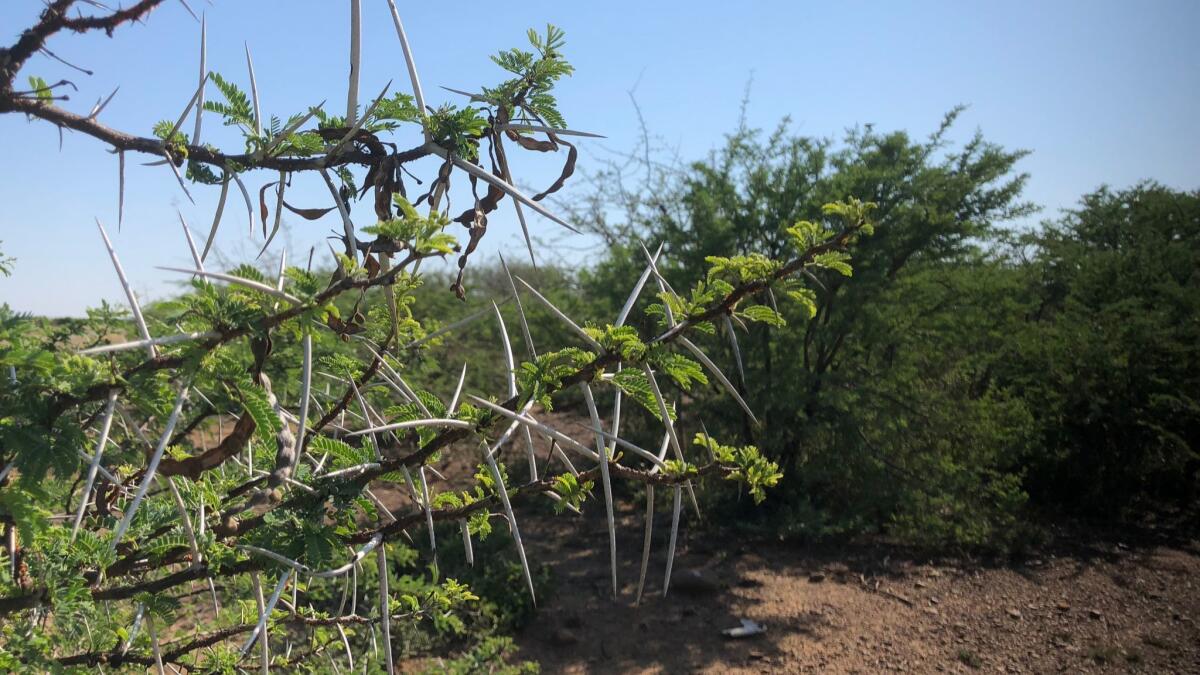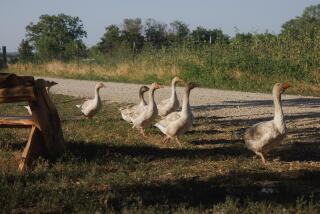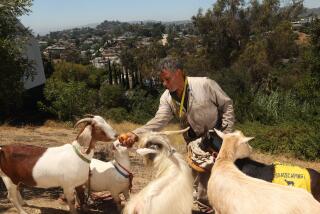They survive droughts, they eat trees — South Africa’s goats are helping farmers weather climate change

Mvezelwa Mhlabunzima holds one of his goats as it is vaccinated on his farm in South Africa’s KwaZulu-Natal province.
- Share via
Reporting from NCUNJANA, South Africa — Mvezelwa Mhlabunzima stands in a wooden pen of a hundred or so shaggy young goats and points out his charges, one by one.
“This one’s a twin,” he says, gesturing to a kid leaning into his leg. He points to two others. “That one’s a twin, with that one … I know them all.”
The 35-year-old farmer in the arid mountains of South Africa’s KwaZulu-Natal province gnaws on a red plastic coffee straw with the look of a harried parent. His young goats are getting antibiotic injections, and there’s a nervous energy in the bleating crowd of brown, black and white kids.
A few clamber up the sides of the wooden pen, as if seeking an escape route into the grazing land beyond, an expanse of spindly acacia trees and short, scrubby green grass.
For Mhlabunzima, who came to help run his family farm after losing his job in Johannesburg, these goats are bringing much-needed stability to the business, which has been at the mercy of the region’s increasingly unpredictable weather.
The farm lost dozens of head of cattle — and thousands of dollars in income — in a drought from 2014 to 2017. At one point, Mhlabunzima’s family herd went from 60 cows to 10. Other farms in the area also lost up to 80% of their herds.
South Africans are coming to grips with how their environment and lives are shifting in the changing climate, as are people across the globe. Climate change is already affecting agriculture in many vulnerable countries, posing a widespread threat to food security, according to the United Nations. Farmers in some drought-stricken nations such as India are abandoning crops now deemed unsuitable as productivity and farmers’ incomes fall.
In southern Africa, temperatures have been increasing since the middle of the last century and are projected to rise drastically across the region by the end of this one, according to the Council for Scientific and Industrial Research, a South African government research body. That’s creating huge challenges for South Africa’s vital agricultural industry, with small-scale cattle farmers hit particularly hard by intensifying dry spells.
Goats could be part of the answer.
Veld goats, native to South Africa, aren’t worth as much as cattle per head, but they fare better in long periods of dry, unforgiving weather, and their populations recover faster. They also have a taste for the trees and bushes that have been impinging on local grasslands, shrinking the space where cattle can graze.
The impact of climate change is already noticeable throughout South Africa, says Guy Midgley, a global change researcher and professor at Stellenbosch University. As in California, the intensity of wildfires has been increasing. Dry periods, including the severe drought that brought Cape Town to the brink of having to turn off residents’ taps, have been getting longer, while rainfall when it comes has become intense, causing more damage.
As for the grasslands, an iconic landscape that extends across southern Africa, scientists believe the rising levels of carbon dioxide in the atmosphere, which the United Nations says reached record levels in 2017, are taking a toll.
For millions of years, southern Africa’s grasslands have thrived in a relatively low carbon dioxide environment, replenished by natural fires that have kept trees and shrubs in their vicinity small. But as carbon dioxide levels have risen, those trees and shrubs that thrive on the greenhouse gas have grown faster while the grasses receded.
In South Africa, more than 20,000 square miles of grasslands have been replaced by woodlands since 1990, according to a survey by the South African National Biodiversity Institute. In neighboring Namibia, the impact has been even more severe, with roughly 100,000 square miles of land affected by bush encroachment, drastically reducing cattle herds and the incomes of tens of thousands of households.
“We used to have big areas of open grass,” says Khonani Majozi, another farmer in Ncunjana. “Now we have to take our animals even farther. You can see the small trees growing instead of grass.”
The problem isn’t unique to southern Africa; bush encroachment has also been tracked in North America and Australia. It’s been a cause of concern in South Africa since the late 19th century, with other factors, such as rainfall, the way livestock are left to graze and how fires are managed, also influencing grassland health.
Though an increase in trees and woody plants means that more carbon dioxide may be captured — to be sure, planting trees has become one global strategy to combat high CO2 levels — some here argue that the loss of income and biodiversity is not a reasonable trade-off for helping to offset emissions that this part of the world is not even responsible for.
“Why should southern Africa sacrifice its beautiful open ecosystems to create forests to suck up the CO2 being emitted by the Northern Hemisphere?” asks Midgley. “It’s completely unfair.”

A few miles from Mhlabunzima’s farm, Rauri Alcock stands at the edge of a lonely road and points at an expanse of thorny acacia trees. “This used to be grassland — open grassland, the whole area,” says Alcock, chief executive of Mdukatshani, a nonprofit organization that has partnered with the government to help farmers increase their goat herds. “A lot of these places have flipped into something we don’t know.”
Goats have been used to keep encroaching trees and shrubs off grasslands in Europe, and in several U.S. cities you can rent a goat herd to eat weeds or unwanted foliage in your field or yard.
Many rural South African households already keep a few indigenous goats. In 2016, there were about 14 million cattle kept on family farms in South Africa, and about 8 million goats, according to the government’s last survey of agricultural households.
Goats are always in demand — they’re widely used in ritual slaughter — but the goat trade that supplies animals for traditional purposes is mostly conducted on an individual basis and not widely commercialized, says Alcock. Goat sacrifice has long been practiced in Zulu culture to mark major life events, such as births and weddings, and the goat’s meat is then eaten within the family.
But fewer than 1% of the goats slaughtered in South Africa are in the commercial sector, according to the Department of Agriculture, Forestry and Fisheries, and goat meat, though common, is mostly not formally traded.
Mdukatshani has been helping farmers build up their herd numbers and also sell goats in a more formal market.
The income farmers get from those sales may make their households more resilient to a changing climate than keeping cattle alone. More than a million cattle died in KwaZulu-Natal province during the 2014-17 drought, with economic losses exceeding $1 billion, according to Mdukatshani’s estimates.
The number of households that own cattle fell from more than 613,000 in 2011 to 588,000 in 2016, according to the government survey. During the same time, the number of households that own goats rose.
“If you’re a cattle farmer, you have to think about what you’re going to do next,” says Alcock.
Not only do they survive droughts better than cattle, but goats also have other advantages in the global climate’s new normal: They are used to traveling long distances each day in the bush, they’re cheaper than cows, and they grow faster, so they’re easier to sell.
“We still keep cattle, but our priority now is goats,” says Bongekile Ndimande, a farmer in her late 60s who lives in Ncunjana. “We can make a quicker turnover.”
Around Mhlabunzima’s farm, there is noticeably less thorny tree growth than the woodier areas beyond the goats’ reach. Until fairly recently, the farm raised mostly cattle, with a few goats on the side. Now, the family keeps 40 cows, 60 sheep and 250 goats.
As he’s increased his goat herd, Mhlabunzima is figuring out how to protect the younger goats from disease, including having them vaccinated. In 2017, he had 90 baby goats, but more than half of them died. In 2018, he “only had one goat die, and that was my mistake,” he says.
Though goats more or less herd themselves — they walk and graze the same paths every day in a pack — Mhlabunzima grumbles they can still be a little high maintenance. Predators in the bush sometimes eat the kids. Females wander off to give birth and then it’s hard to find them. But, he says, “It’s new income. I’m happy with that.”
Just before lunch, Mhlabunzima’s younger brother opens the gate to the goat pen and gives a loud whistle. The goats trot out, heading down a well-worn path out into the bush to graze. A couple of goats at the back of the pack linger at a young acacia sapling, and dig in.
Mahr is a special correspondent.
More to Read
Sign up for Essential California
The most important California stories and recommendations in your inbox every morning.
You may occasionally receive promotional content from the Los Angeles Times.













